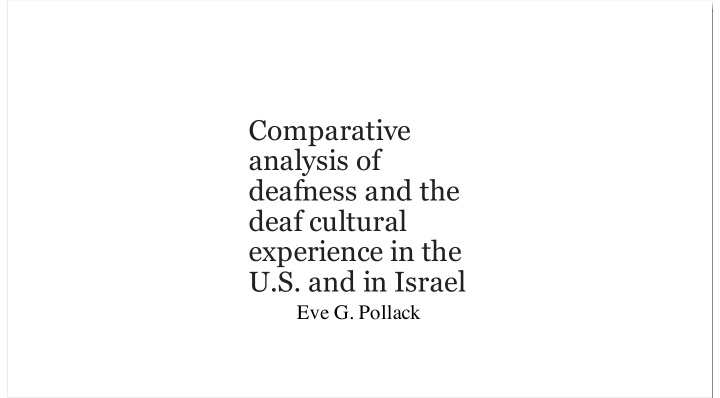



Comparative analysis of deafness and the deaf cultural experience in the U.S. and in Israel Eve G. Pollack
History: ● Americans with Disabilities Act (ADA) as well as the Equal Rights for People with Disabilities Bill (ERPD) in Israel were created in hopes of gaining new opportunities for disabled individuals. ● Historically, members of the Deaf community have not been treated fairly or equally. A lot of the time they were seen as lesser than their hearing counterparts. ● Overtime, individuals became intrigued on exploring deafness further including how to best teach Deaf individuals which begun the oralism vs. manualism teaching method debate.
Comparison of the disability laws in the US & Israel: ● The ERPD is broader than the ADA which goes into detail defining disabilities ensuring inclusion of all disabilities rather than leaving it up to observation and assumptions most likely leading to misinterpretation. ● The ERPD is ⅕ the size of the ADA. ● Overall, the Israeli population is much smaller than the US leading to disparities between the demand of the laws and the reaction of the lawmakers.
Legal protections for the Deaf: United States: Israel: ● ADA was created as a revision of ● ERPD aimed to secure disabled the Rehab Act of 1973 to ensure better individuals with equal rights regarding treatment of disabled individuals by their ability to make decisions for the federal government and society as themselves, inclusion in society as a a whole whole, receival of the same services ● Individuals with Disabilities offered to other members of society. Education Act (IDEA) of 1990 created to provide disabled individuals appropriate educational opportunities including environments
Historical treatment of the Deaf ● Overtime, society’s perspective of members of the Deaf changed. ● Labeled as being deaf & dumb, forbidden to own land, purchase and sell goods, etc. ● Many doctors deemed Deafness as an illness therefore requiring a cure which led to a variety of attempts to “cure” deafness that were inhumane such as: blowing loud instruments in the ear or pouring liquids such as garlic juice, honey, etc in the ear. ● The Renaissance began the realization that deaf people are humans too and therefore should be treated like humans which also grew an interest in the educating of the deaf.
Oralism: Manualism: ● ● Focused on lip reading, Encouraged the use of a repeating mouth shapes and combination of movements as well as vocal fingerspelling, gesture, and exercises that encourage signs instead of focusing on oral language deaf students speech ● ● Discouraged and Believers of the sometimes even banned the manualist method felt that use of sign language taking away the use of sign language was taking away their deaf identity
Deafness in society: ● Its an invisible disability meaning that from just a look someone may not to be able to tell that someone is deaf ● Lack of resources typically available to aid deaf individuals in everyday activities (concerts, TV shows, radio, etc.) further isolating them from society ● Deafness exists everywhere around the globe and is not limited by gender, race, age, or religion. ● Hearing loss is a spectrum so it is important to note that two deaf individuals won't necessarily have the same degree of hearing loss therefore having different abilities
Deaf culture: ● Deaf culturalists embrace deafness as part of their identity while society at large views deafness as a disability ● Deafness as an invisible disability: not immediately apparent to others. ● Deaf culturalists oppose mainstreaming and Cochlear Implants which they view as degrading as well as pulling them further away from their Deaf identity. ● Language and cultural gap between the Deaf world and the Hearing world.
Looking towards the future: There is still much work to be done in both the United States and Israel regarding their respective Deaf communities, however, there has also been much progress which should definitely be noted!
Recommend
More recommend